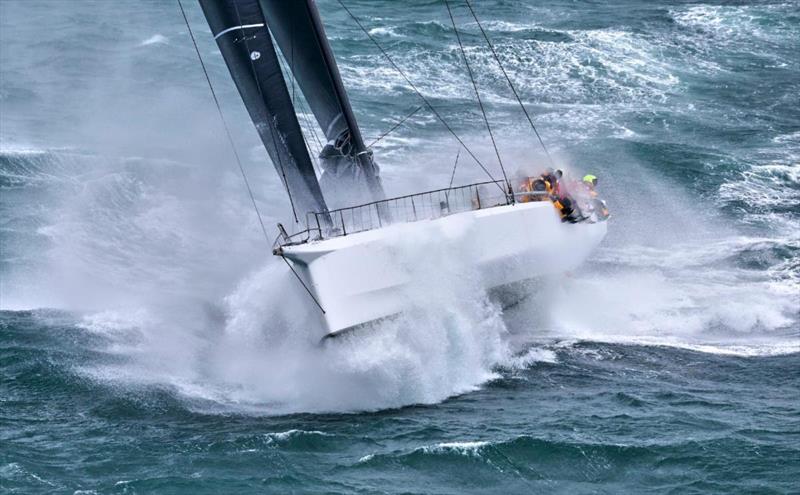
RORC Transatlantic Race: Two months to go
by Louay Habib / RORC 11 Nov 2024 17:02 GMT
12 January 2025

Bryon Ehrhart's 88ft (27m) Maxi Lucky (USA) © Carlo Borlenghi / ROLEX
With just two months before the start of the 3,000 mile race across the Atlantic, the RORC Transatlantic Race fleet is still growing, with more entries expected in the coming months.
Boats have been arriving in Marina Lanzarote with many more en route for the race start on 12th January 2025. As with all 11 editions in the past, a variety of boats and sailors will line up for this epic challenge.
The battle for monohull line honours and the IMA Transatlantic Trophy will be between two new comers for the RORC Transatlantic Race; Bryon Ehrhart's 88ft (27m) Maxi Lucky and Christian Zugel's Volvo 70 (21.5m) Tschüss II. Both boats are from the United States and designed by Juan Kouyoumdjian. Lucky is the favourite, but Tschüss II should not be underestimated. The RORC Transatlantic Monohull Race Record was set by Comanche, skippered by Mitch Booth in 2022: 07 Days 22 Hrs 01 Mins 04 Secs.
Bryon Ehrhart's Maxi Lucky has a stellar crew for the race including Charlie Enright, Joca Signorini and Peter Van Niekerk. Lucky's navigator will be Juan Vila who will be taking part in his first RORC Transatlantic Race. The Spaniard is one of the very few sailors to have won the Jules Verne Trophy, the Volvo Ocean Race, and the America's Cup.
"This is a race that I have always liked to do," commented Vila. "I have done similar races in the past but a trade wind race in January across the Atlantic is very special for any navigator because it is always challenging; you have to adapt and use all your knowledge for this race. This is a very fast route across the Atlantic and Comanche's record from 2022, at nearly 16 knots average, is very impressive.
"At the beginning of the race, we have to navigate through pretty much the whole Canary Islands, especially the lee of Tenerife. It is an early call in the race to decide whether to sail in the lee of islands or sail the extra distance to avoid them.
"In the open Atlantic, ideally for Lucky we will need broad reaching conditions, that is the boat's fastest angle. Even with the huge improvement in satellite communications and accuracy of weather models, for forward planning you have to decide how long you can trust the weather model for. Maybe the routing is made because of a situation in the future which is not going to happen, or maybe the routing is not taking into account local affects; you have to adapt it. Local factors such as trade wind showers can be used to advantage to gain miles but they can be quite tricky. Overall, you have to make up your own mental picture of what is going to happen.
"The race starts in higher latitudes and goes to lower latitudes at the end, so transitions are very likely and dependent on how the Jet Stream is running. Getting the transitions right is where gains and losses can be made. The timing from where you jump from a North Atlantic type system to trade wind weather is crucial. If you delay too much the door closes, if you go too early, you might make a longer course," concludes Vila.
For Christian Zugel's first transatlantic race, Tschüss II brings a skilled crew co-skippered by Johnny Mordaunt, including Stu Bannatyne, Tristan Louwrens and Chris Welch from the 2024 overall winner Warrior Won. Tschüss navigator will be Campbell Field, who tasted IRC Zero victory on Botin 52 Tala in 2022.
Field notes that while weather data and computing power have advanced, the approach remains similar to decades past: "Daily forecast reviews, strategy updates and coordination on boat prep and sail choices. Also remembering to get on deck and enjoy the view, help where needed and catch a nap every now and then. Local weather factors like island effects, cloud lines and squalls are crucial," he says. "I'm excited to race again on such a formidable boat with a fantastic team."
The youngest team in the 2025 RORC Transatlantic Race is the German JV52 Haspa Hamburg, with nine of 12 crew members under 30. Owned by the Hamburgischer Verein Seefahrt (HVS), which has trained young sailors on ocean yachts since 1903, Haspa Hamburg is a familiar sight in RORC races. The HVS has been racing with RORC for decades. Skipper for the 2025 RORC Transatlantic Race will be Wibke Borrmann, joined by her husband Lars and their daughter Inken, one of three 19-year-olds on board.
"Our goal is to give young people the chance to race offshore; a core mission of the HVS," said Wibke. After the RORC Transatlantic Race, Haspa Hamburg will race in the RORC Caribbean 600, then race back in the West-East Transatlantic Race to join the Rolex Fastnet Race. "Safety is our priority," Wibke added. "I hope the crew will love the experience enough to want to sail back. Offshore racing is a unique way to live intensely, trusting and depending on each other."
The RORC Transatlantic Race is supported by Calero Marinas, the International Maxi Association, and the Yacht Club de France. The RORC fleet will set off on the 12th of January from Marina Lanzarote to race 3,000 miles across the Atlantic Ocean, bound for Camper & Nicholsons Port Louis Marina in Grenada, West Indies.
View current entries
For more information including on-line entry and the Notice of Race: www.rorctransatlantic.rorc.org